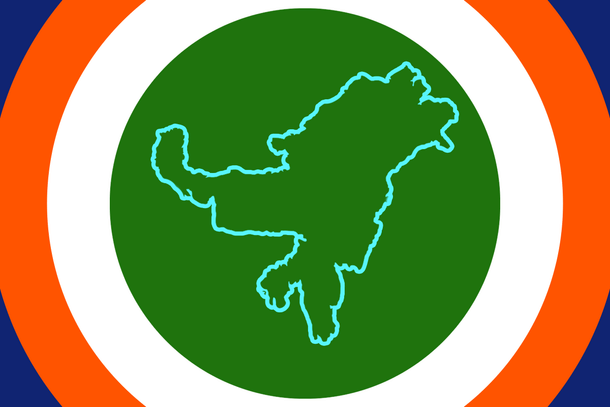Politics
No More Tyranny Of Distance: Northeast India Is Now Mainstream India
Pratim Ranjan Bose
Mar 02, 2023, 07:42 PM | Updated 08:54 PM IST
Save & read from anywhere!
Bookmark stories for easy access on any device or the Swarajya app.


The overall trend is settled. The political stability of the northeastern region remains intact with the BJP gaining strength both directly and indirectly in the region’s politics.
The Manik Saha-led BJP government is back in Tripura.
Sitting Chief Minister Neiphiu Rio’s National Democratic Progressive Party (NDPP) and BJP swept the Nagaland election.
And, Wharton School-educated Conrad Sangma of the National People’s Party (NPP) will retain power in Meghalaya with some post-poll alliances which the BJP is likely to join.
This political scenario deserves a more detailed review. But before that the bigger story is missed: When was the last time you saw national channels spending hours discussing the election in states with populations of 20-35 lakh each, which is the size of a district in major states?
Once a forgotten land
Let's face it. Until some 10-15 years ago, the northeastern region was living in near-complete oblivion, with the media coverage of the region heavily biased towards security and law and order stories only.
The rest of the space was left for rich man’s fantasies: head-hunting, dog meat, Rhino and other mysteries. India used to look at the region in the same manner as the English once saw us – ‘a land of snake charmers’.
The region on its part used to treat people from the rest of India as “outsiders.” Independence Day was observed only in pockets.
The gap between the two was exploited by vested interests. Christian evangelists were hyperactive till the 1970s and so were conversions. Bangladesh was a major host to anti-India forces till Sheikh Hasina’s arrival to power in 2009.
Anup Chetia, the founder of the moribund terrorist group United Liberation Front of Asom (ULFA), recently claimed that the “10 trucks of arms seized in Bangladesh in 2004 did not belong to the ULFA alone.”
The 2004-09 boom bypassed the region. The resultant isolation was giving rise to pro-China sentiments for a decade preceding the Narendra Modi government in Delhi. This was primarily due to the pathetic difference in infrastructure and growth outlook between the northeast, and the rest of India.
The Agartala airport was virtually an upgraded version of a cattle shed. Roads across the region looked war-torn. The North bank of Brahmaputra in Assam was practically inaccessible for half-a-year during the rainy season.
Till 2017, Arunachal didn’t have a single commercial airport. From the state capital of Itanagar to Delhi, it was an overnight journey via the Guwahati airport.
Last but not least, almost the entire region was under the Armed Forces (Special Powers) Act (AFSPA), 1958, which was applicable to "disturbed areas". Till about 2017 night movement on the highway, in many stretches, was allowed only under police protection.
End of isolation
As of 2023, AFSPA is largely withdrawn from the region. The Union home minister Amit Shah recently said that the rest would be withdrawn in the next three to four years. Going by the precedence this was believable.
The entire region has undergone dramatic changes in barely a decade.
Arunachal now has four airports.
Since 2019, the number of bridges on the Brahmaputra doubled to six. In the next five years, the number should increase by more than double. Assam’s North bank is now easily accessible.
Nagaland got its second rail station after a century and by next year, trains will reach the state capital of Kohima.
The rail track is also on its way to Aizawl in Mizoram. And, Meghalaya is witnessing a four-lane highway building spree.
The results are manifested in more ways than one. In 2010, Meghalaya saw the arrival of more than 6.52 lakh domestic tourists. Over the next five years, the footfall increased by 10 percent.
Between 2015 and the pre-covid year of 2019, the arrivals increased by 65 percent. The intermittent period saw a doubling of operational airports in the region. The growth rate of flights surpassed the national average.
The socio-cultural impacts are tremendous. A decade or two ago, beef and pork were commonly offered meat in hotels in this Christian-dominated state, in complete disregard to the sensibilities of ‘outsiders.’
With wealthier tourists from southern and western India now flocking to Meghalaya; top-end resorts sprung up in the nooks and corners of the state. “Veg Only” and “No Beef” boards in hotels and restaurants also came up.
Mainstreaming of NE
The moot point is connectivity ended the isolation of the Northeast. Some may point to the dilution of local culture. But, the optimists should refer to this as the mainstreaming of roughly four percent of the country’s population.
And, it is working both ways. The private hospitals in Kolkata thrive on Manipuri nurses. English-educated and courteous Mizo and Naga youth form a substantial part of the hospitality industry staff in southern states.
Highly educated young boys and girls with rich work experience across the country and beyond are giving Shillong, Guwahati and Imphal a head start in the start-up revolution. They are networked with the rest of the country.
Travel across the region and you will feel the youth in general are more Indian than ever and keenly follow national politics. They want to be part of rising India.
These sentiments are tapped by the young leaders in the region like Conrad Sangma or Assam Chief Minister Himanta Biswa Sarma or even the Tipra Motha chief ‘Bubagra’ (king) Pradyot Bikram Manikya Deb Barma in Tripura.
Unlike the old-school politicians from the region, they don’t thrive on politics of isolation. They know that development will fuel a further rise in aspiration. It is imperative to break the glass walls from the past, to mitigate that.
In the interim period, they might be nursing the old constituencies like Ahom pride or Garo supremacy or Tipraland, but that’s merely a transitional phase.
These changing political values, which will be more prominent in the next decade, is BJP’s gift to northeast politics.
Their experiment with Biplab Deb in Tripura might have gone horribly wrong. But, on the brighter side, they are not afraid to experiment.
BJP’s futuristic politics
Look closely, and you will see that BJP is working on a long-term strategy.
In a region which is highly divided in terms of ethnic and religious identities, BJP is working on a twin strategy of nursing its own talents like Union law minister, Kiren Rijiju from Arunachal, and also offering space to talents from other entities.
Union minister Sarbananda Sonowal was in Asom Gana Parishad – once the torchbearer of Ahom pride. Biswa Sarma and Manik Saha came from Congress.
While a lot of newsprint was spent on breaking the NPP-BJP coalition in Meghalaya, the truth remains that Conrad Sangma has excellent personal relations with the BJP top brass.
Back in 1999, Conrad’s illustrious father, late P A Sangma revolted against Sonia Gandhi’s leadership in Congress on the grounds of her foreign origin and maintained his stance till his death in 2016.
This piece of history makes the NPP a natural ally of the BJP. Differences between the two are temporary and more linked to short-term electoral prospects. Ideally, they should ride on each other’s strength.
Northeast’s mainstreaming will take time to complete. But the BJP has read it well. Congress is struck in the memory of the good old days, which no longer exist.





